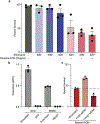Neurotoxic reactive astrocytes induce cell death via saturated lipids
- PMID: 34616039
- PMCID: PMC12054010
- DOI: 10.1038/s41586-021-03960-y
Neurotoxic reactive astrocytes induce cell death via saturated lipids
Abstract
Astrocytes regulate the response of the central nervous system to disease and injury and have been hypothesized to actively kill neurons in neurodegenerative disease1-6. Here we report an approach to isolate one component of the long-sought astrocyte-derived toxic factor5,6. Notably, instead of a protein, saturated lipids contained in APOE and APOJ lipoparticles mediate astrocyte-induced toxicity. Eliminating the formation of long-chain saturated lipids by astrocyte-specific knockout of the saturated lipid synthesis enzyme ELOVL1 mitigates astrocyte-mediated toxicity in vitro as well as in a model of acute axonal injury in vivo. These results suggest a mechanism by which astrocytes kill cells in the central nervous system.
© 2021. The Author(s), under exclusive licence to Springer Nature Limited.
Figures














References
-
- Liddelow SA & Barres BA Reactive Astrocytes: Production, Function, and Therapeutic Potential. Immunity 46, 957–967 (2017). - PubMed
METHODS REFERENCES:
-
- Dugas JC & Emery B Purification of Oligodendrocyte Precursor Cells from Rat Cortices by Immunopanning. Cold Spring Harbor Protocols 2013, pdb.prot070862 (2013). - PubMed
-
- Ullian EM, Sapperstein SK, Christopherson KS & Barres BA Control of Synapse Number by Glia. Science 291, 657–661 (2001). - PubMed
-
- Hedrick VE, LaLand MN, Nakayasu ES & Paul LN Digestion, Purification, and Enrichment of Protein Samples for Mass Spectrometry. Curr Protoc Chem Biology 7, 201–222 (2015). - PubMed
Publication types
MeSH terms
Substances
Grants and funding
LinkOut - more resources
Full Text Sources
Molecular Biology Databases
Miscellaneous

